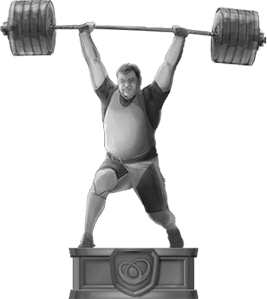Editor’s Note: We present another article by Den Blonde Ulven.
I have been on a new training regime the past few months and the programming has been unorthodox and extremely odd compared to all strength and conditioning programs I’ve ever been acquainted. I am unsure if it is a new paradigm of thinking, but it is most certainly worth spreading the word. I highly recommend this type of training to athletes, martial artists, and especially manual labor workers.
My trainer is a man dedicated to his craft and knows more about body mechanics, nutrition, and general health than any mainstream doctor or practitioner that exists today. I am relying on his programming and a bit of his knowledge to convey the macro perspective on what I am coining “Awkward Movement Training”.
The main philosophy behind the programming is to train the body to be adaptive instead of hyper proficient. Much of the foundation is similar to Westside Barbell’s where they train around the lift in addition to the lift itself. Think of a bench press. If one trains bench and only bench, the body becomes extremely proficient at bench.
But the nature of existence requires more than a strong chest pushing something straight up into the air. Angles change, body positions shift, optimal loading is usually not an option. What about when one needs to bend down on one knee? Or pull up on a 2×4 at a weird angle? Or meet a tackle from a rugby line? Or attempt a single leg takedown after failing to wrap up the double? Or dodging a hook with a quick torso leanback follow up with an immediate cross counter-punch? These types of movements are not accounted for in standardized strength training. So, train the body to become adaptive instead.
What does adaptive mean in this context? It means constantly throwing new things at the body so that it never “settles” into a predictable habit. The mechanical goal is to get the body to recruit muscles beyond the readily obvious, and needs to be trained as such. Movement based training accomplishes this.
Because of the custom nature of the work, there exists no standardized programming routine. The best I can do is give specific examples in the hope the larger pattern is realized. Examples provide the best conduit to teach:
- Instead of a standard set of dumbbell flys, perform a set one hand at a time. Or one handed with a slight decline/incline. Or with resistance bands of differing strengths.
- Rather than a standard squat, perform while balancing on a bosu ball, one footed, and maybe alternating each hand above the head.
- Lateral jumps off each foot.
- Medicine ball rotational passes and ground throws.
- Resistance band rotational swims, circles, and explosive punches straight into hanging knee tucks.
- Spiderman crawls or hamstring scooter scoots.
- Bodyweight exercises performed explosively or with as many reps as possible.
- Log/farmers carries.
- Multi-gripped pull-ups.
- Alternating regular barbell and dumbbell movements for kettlebells/swiss bar/buffalo bar exercises.
Regarding levels of intensity, my trainer categorized all exercise into two groups: training and performance. Performance intensity requires maximum output. Training intensity requires enough to not risk injury. If one is a martial artist, the gym and exercises are themselves training. It is usually not worth pushing far beyond a known limit just to hit that next PR, because to risk development in the ring is not a worthy cost to incur. The ring, fight prep, and street are performance.
It should be noted that this is not a replacement for standard strength training. To build a strong squat, one must work high bar, low bar, and front squat like it’s a job. Squatting is hands down the most efficient and effective exercise to teaching the body how to perform a better squat. This awkwardness programming is designed to be added to a base level of barbell and dumbbell work and is not pure powerlift training.
It is also worth noting that this is different than traditional sport specific strength training, because the focus is not purely on strength. There is a lot of resistance work, negatives, bodyweight movements, reps to exhaustion, and many exercises that border on cardio. My main compound lifts have arguably stalled, but my body mechanics in wrestling, striking, submissions, throws, and armored combat have jumped leaps and bounds in terms of efficiency and ease of movement. My body awareness in space and my movement efficiency has risen to previously unknown heights and I attribute the vast majority of it to this Awkward Movement Training.
You can find me on Social Galactic. I attempt to post at least once a day-
@DenBlondeUlven
You can also email me-
denblondeulven@protonmail.com










Get a woodstove, chainsaw, pickup truck (or trailer) and a splitting maul and wedges. Strength, cardio, strategy and awareness training all in one shot.
Well I have the pickup at least! But I agree hand splitting wood was one of the best exercises I did. Now I am old enough and a city dweller, so have to rely on a gym. The owner of the gym has everything you need to practice the awkward method, including a sledge hammer and a tire to beat on. At 63, I’m in almost as good a condition as I was at 20, without the endurance maybe, but in pretty good shape for an old buck.